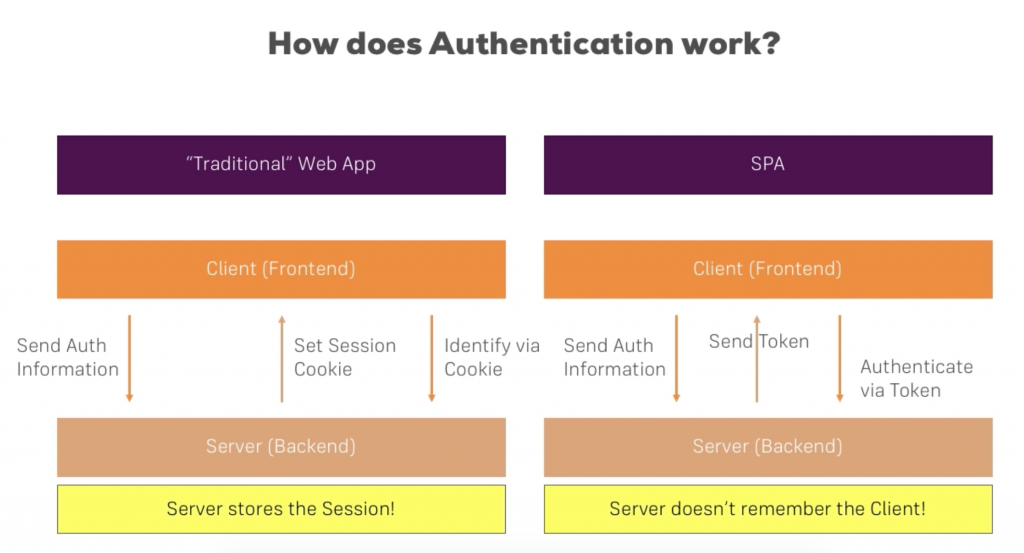Module introduction
- We want allow only logged in users to modify recipes
How Authentication works in SPAs
- In SPAs authentication is managed by tokens
More about jWT
- JSON Web tokens: https://jwt.io/
- https://jwt.io/introduction/
Creating a signup page and route
- We create a Sign up form page and his route “/signup”. All associated to a auth/signup.component
Setting up the firebase SDK
- In firebase console we need to enable basic authentication in the “Authentication” menu option.
- We need to install firebase npm package
sudo npm install firebase --save
NOTE: In a normal backend you can have a available endpoint to retrieve a valid token but firebase hasn’t.
- Create an auth/auth.service.ts with a signupUser method
- Initialize firebase credentials in a app level: app.component.ts
...
import * as firebase from 'firebase';
...
export class AppComponent implements OnInit{
...
ngOnInit() {
firebase.initializeApp({
apiKey: "AIzaSyCqHQQ7gtNxkERmJzTBDfkn_Sq_2LeY9qc",
authDomain: "ng-recipe-book-5333b.firebaseapp.com"
});
}
Signing Users Up
auth.service.ts
import { Injectable } from '@angular/core';
import * as firebase from 'firebase';
@Injectable()
export class AuthService {
signupUser(mail: string, password:string) {
firebase.auth().createUserWithEmailAndPassword(mail, password)
.catch(
error => console.log(error)
);
}
}
signup.component.ts
onSignup(form: NgForm) {
const mail = form.value.email;
const password = form.value.password;
this.authService.signupUser(mail, password);
}
Signing Users In
- We create /signin route and Signin component calling signinUser method on auth service
auth.service.ts
signinUser(mail: string, password:string) {
firebase.auth().signInWithEmailAndPassword(mail, password)
.then(
response => console.log(response)
)
.catch(
error => console.log(error)
);
}
- Firebase store i the browser information of logged user. You can check it in console -> Application –> Local Storage
- There it is the accessToken we will using for make future requests.
Requiring a Token (in the Backend)
- For requiring authentication in the firebase (our backend) we need to set up database rules in the firebase console:
{
"rules": {
".read": "auth != null",
".write": "auth != null"
}
}
Sending the token
- Now for making Fetch Data and Save Data action we need to append accessToken of logged users in the http requests.
auth.service.ts
token: string;
getToken() {
firebase.auth().currentUser.getToken()
.then(
(token:string) => {
this.token = token;
}
);
return this.token;
}
signinUser(mail: string, password:string) {
firebase.auth().signInWithEmailAndPassword(mail, password)
.then(
response => {
firebase.auth().currentUser.getToken()
.then(
(token:string) => {
this.token = token;
}
)
}
)
.catch(
error => console.log(error)
);
}
data-storage.service.ts
- We append token in the url of the requests
storeRecipes() {
const token = this.authService.getToken();
return this.http.put('https://ng-recipe-book-5333b.firebaseio.com/recipes.json?auth='+token,
this.recipesService.getRecipes());
}
Checking and using Authentication status
- We want to show dropdown menu at the top right only for authenticated users
auth.service.ts
isAuthenticated() {
return this.token != null;
}
header.component.ts
constructor(private dataStorageService: DataStorageService,
private recipesService: RecipesService,
private authService: AuthService) { }
header.component.html
<ul class="nav navbar-nav navbar-right">
<ng-template [ngIf]="!authService.isAuthenticated()">
<li><a href="/signin">Sign in</a></li>
<li><a href="/signup">Sign up</a></li>
</ng-template>
<li class="dropdown" appDropdown *ngIf="authService.isAuthenticated()">
<a style="cursor: pointer;" class="dropdown-toggle" role="button">Manage <span class="caret"></span></a>
<ul class="dropdown-menu">
<li><a style="cursor: pointer;" (click)="onSaveData()">Save Data</a></li>
<li><a style="cursor: pointer;" (click)="onFetchData()">Fetch Data</a></li>
</ul>
</li>
Adding a Logout button
auth.service.ts
logout() {
firebase.auth().signOut();
this.token = null;
}
Route protection and redirection example
- Protect some routes for only logged in users
auth/auth-guard.service.ts
import { Injectable } from '@angular/core';
import { CanActivate, ActivatedRouteSnapshot , RouterStateSnapshot} from '@angular/router';
import { AuthService } from './auth.service';
@Injectable()
export class AuthGuard implements CanActivate {
constructor(private authService: AuthService) {}
canActivate(route: ActivatedRouteSnapshot, state: RouterStateSnapshot) {
return this.authService.isAuthenticated();
}
}
app-routing.module.ts
...
{ path: 'new', component: RecipeEditComponent, canActivate: [AuthGuard]},
{ path: ':id', component: RecipeDetailComponent},
{ path: ':id/edit', component: RecipeEditComponent, canActivate: [AuthGuard]}
...
- After sign in we redirect to main page:
auth.service.ts
signinUser(mail: string, password:string) {
firebase.auth().signInWithEmailAndPassword(mail, password)
.then(
response => {
this.router.navigate(['/']);
firebase.auth().currentUser.getToken()
.then(
(token:string) => {
this.token = token;
}
)
}
)
.catch(
error => console.log(error)
);
}
Wrap up
Possible improvements


